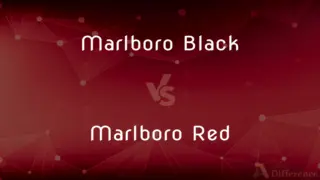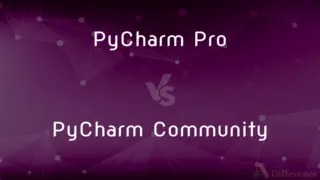Ferric Alum vs. Non Ferric Alum — What's the Difference?
By Tayyaba Rehman — Published on January 15, 2024
Ferric Alum contains iron, while Non Ferric Alum doesn't. Both are used in water purification.

Difference Between Ferric Alum and Non Ferric Alum
Table of Contents
ADVERTISEMENT
Key Differences
Ferric Alum and Non Ferric Alum are both types of alum, a class of chemical compounds primarily used in water purification and dyeing processes. Ferric Alum contains iron, which is evident from the term "ferric" indicating the presence of iron, while Non Ferric Alum doesn't contain iron.
In the context of water treatment, Ferric Alum and Non Ferric Alum serve as coagulating agents. Ferric Alum, due to its iron content, can sometimes introduce a slight coloration to the water. On the other hand, Non Ferric Alum provides a clearer solution, making it more suitable for certain applications where water clarity is paramount.
The chemical formula also differentiates Ferric Alum and Non Ferric Alum. Ferric Alum has a formula of FeSO₄.(NH₄)₂SO₄.24H₂O, whereas Non Ferric Alum has a formula of Al₂(SO₄)₃.18H₂O.
Ferric Alum and Non Ferric Alum have different costs associated with their production and usage. Generally, due to the absence of iron, Non Ferric Alum tends to be more expensive than Ferric Alum.
Lastly, both Ferric Alum and Non Ferric Alum find applications beyond water treatment. For example, Ferric Alum is sometimes used in the paper industry, while Non Ferric Alum might be used in cosmetics and baking powder.
ADVERTISEMENT
Comparison Chart
Iron Content
Contains iron.
Doesn't contain iron.
Water Clarity
Can introduce slight coloration.
Provides clearer solution.
Chemical Formula
FeSO₄.(NH₄)₂SO₄.24H₂O
Al₂(SO₄)₃.18H₂O
Cost
Generally cheaper.
Tends to be more expensive.
Other Applications
Used in paper industry.
Used in cosmetics and baking powder.
Compare with Definitions
Ferric Alum
A chemical with the formula FeSO₄.(NH₄)₂SO₄.24H₂O.
The chemical composition of Ferric Alum differentiates it from other types of alum.
Non Ferric Alum
A chemical with the formula Al₂(SO₄)₃.18H₂O.
Non Ferric Alum's chemical formula is devoid of any iron compounds.
Ferric Alum
A crystalline substance with iron components.
Ferric Alum crystals are sometimes used in various industrial applications.
Non Ferric Alum
A type of alum without iron content.
Non Ferric Alum is preferred when a colorless solution is required.
Ferric Alum
A type of alum containing iron.
The presence of iron in Ferric Alum gives it a distinctive color.
Non Ferric Alum
Used in cosmetics due to its clarity.
Non Ferric Alum is often an ingredient in certain cosmetic products.
Ferric Alum
Commonly used in the paper industry.
Paper manufacturers use Ferric Alum for sizing and coating processes.
Non Ferric Alum
A white crystalline substance.
The white crystals of Non Ferric Alum are easily distinguishable.
Ferric Alum
A coagulating agent used in water treatment.
Water treatment plants often use Ferric Alum to clarify water.
Non Ferric Alum
A coagulating agent producing clearer water.
For pristine water clarity, many plants opt for Non Ferric Alum.
Common Curiosities
What is Ferric Alum?
Ferric Alum is a type of alum containing iron.
What are the primary uses of Ferric Alum and Non Ferric Alum?
Both are primarily used in water purification, with Ferric Alum also used in the paper industry.
How is Non Ferric Alum different from Ferric Alum?
Non Ferric Alum doesn't contain iron, whereas Ferric Alum does.
Do Ferric Alum and Non Ferric Alum have the same chemical formula?
No, Ferric Alum is FeSO₄.(NH₄)₂SO₄.24H₂O, while Non Ferric Alum is Al₂(SO₄)₃.18H₂O.
Which alum provides clearer water?
Non Ferric Alum provides clearer water compared to Ferric Alum.
Is Ferric Alum more expensive than Non Ferric Alum?
Generally, Non Ferric Alum is more expensive due to its absence of iron.
Why might one choose Ferric Alum over Non Ferric Alum?
Ferric Alum might be chosen for cost-effectiveness or specific industrial applications.
Can Ferric Alum be used in cosmetics?
Non Ferric Alum is more commonly used in cosmetics due to its clarity.
Which is more environmentally friendly, Ferric Alum or Non Ferric Alum?
Both have their environmental concerns, but proper handling and disposal minimize their impact.
How can I identify Ferric Alum visually?
Ferric Alum may have a slight coloration due to its iron content.
Are there health concerns associated with either?
Both are generally safe in their intended applications, but ingestion or excessive exposure can be harmful.
Can Non Ferric Alum introduce color to water?
No, Non Ferric Alum provides a clearer solution without coloration.
Is the coagulating ability the same for both?
Both serve as coagulating agents, but their efficiency might vary based on the application.
Can I use Ferric Alum for baking?
Non Ferric Alum is the one more commonly used in baking powder.
Are there any other types of alum?
Yes, there are various types of alum, but Ferric and Non Ferric are two of the most common.
Share Your Discovery

Previous Comparison
Diapers vs. Pull-Ups
Next Comparison
Sodium Sulphate vs. Sodium SulphiteAuthor Spotlight
Written by
Tayyaba RehmanTayyaba Rehman is a distinguished writer, currently serving as a primary contributor to askdifference.com. As a researcher in semantics and etymology, Tayyaba's passion for the complexity of languages and their distinctions has found a perfect home on the platform. Tayyaba delves into the intricacies of language, distinguishing between commonly confused words and phrases, thereby providing clarity for readers worldwide.













































